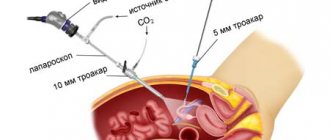Risk factors
The main principle on which the diagnostic capabilities of computed tomography are based is the study of body tissues using X-rays that are absorbed and transmitted to varying degrees. They are inherently ionizing: passing through tissue, the rays are capable of changing the structure of atoms and molecules.
In this case, tissues react differently to x-rays. Blood cells, epithelium, and male germ cells are most sensitive to radiation. Bone and nerve tissue are less sensitive. Under the influence of frequent radiation, serious diseases can develop, primarily associated with a violation of blood composition.
It also negatively affects the fetus, especially at the stage of formation of systems and organs. The first trimester is characterized by rapid cell division and tissue differentiation. X-rays passing through dividing cells can damage the DNA chain and disrupt the structure of proteins, which leads to mutation or cell death. Possible consequences of exposure to X-rays in the first trimester are shown in the table.
| Duration in weeks | Danger |
| Until 3 | Death of the embryo |
| Up to 5 | Death of the embryo or pathology of the thyroid gland and heart |
| At 6 n | Changes in the nervous and circulatory systems, pituitary gland abnormalities, abnormal development of limbs |
| 7 | Anomalies of the abdominal organs, pathologies of the hematopoietic system |
| 8 | Cleft lip (cleft palate) |
| 9-10 | Bronchopulmonary pathologies |
| 10-12 | Disturbances in the formation of the thyroid gland |
However, the strength of the negative action and, accordingly, the danger it poses depends on several factors :
- Areas to explore.
- Characteristics of the CT installation.
- Parameters set by the operator.
Is it possible to have a CT scan during pregnancy?
The safe level of radiation that can be used for the fetus is no more than 1 µSv (microsievert). When performing a CT scan of the abdominal cavity, this figure reaches 11 μSv. Doctors strongly do not recommend doing a CT scan during pregnancy. If it is necessary to examine the abdominal cavity, MRI is considered a safe and no less informative method; in some cases, the abdominal cavity can be examined using ultrasound.
CT scanning is contraindicated for pregnant women
If a woman finds out about pregnancy after a CT scan was performed, you can consult a gynecologist who is monitoring the pregnancy. It is necessary to take into account all conditions - the gestational age at which the woman was examined, the localization of radiation (CT of the abdominal and chest cavity in the early stages is detrimental to the fetus), the time of exposure to harmful radiation, and ultrasound examination data. Doctors in many cases recommend an abortion, but you can wait for the results of the first prenatal screening to assess development - at this time, many defects are already clearly visible during ultrasound. Natural selection often works - a non-viable fetus is itself rejected by the body at an early stage.
Features of the procedure
X-rays negatively affect the fetus at the stage of formation of organs and systems.
Is it possible to do a CT scan during pregnancy? Doctors' answer to this question is unequivocal - it is impossible, since X-rays negatively affect the fetus. However, there are situations when performing a computed tomography becomes a forced and the only possible measure:
- Maternal hemorrhage.
- Acute surgical pathologies.
- Thromboembolism.
- Spinal cord injuries.
In addition, not all patients know at the time of the study that pregnancy has occurred. The degree of risk to the fetus depends on several factors :
- What area is being examined? Diagnostics of the arms, legs, neck, and head are less dangerous. It is important in all these cases to cover the stomach with a special lead apron.
- Gestational age. The first weeks are especially dangerous, when the embryo is vulnerable to external influences.
- The CT scanner used. As already mentioned, the multispiral device has a lower dose compared to the linear one. A dental tomograph gives a very low dose, and many doctors believe that it is possible to perform a dental CT scan during pregnancy.
If the study was carried out at an early stage, the woman is often offered to terminate the pregnancy. However, such categoricalness is not always justified, especially taking into account modern screening systems and high-precision ultrasound machines capable of detecting fetal pathologies. In addition, the “all or nothing” rule applies in this case. It is believed that if no miscarriage occurs within two months after the procedure, it means that the negative impact was avoided and you can calm down.
Features of scanning in pregnant women
Diagnosis of pregnant women is carried out according to the same scheme as usual. No special preparation is required. The only difference is the use of a special X-ray reflective apron, a lead blanket. They cover the stomach of a woman in “position” in order to at least to some extent reduce the number of X-rays that penetrate inside the body.
For diagnosis, the radiologist sets the minimum possible dose of radiation intensity. At the same time, he will still be able to visualize the structure and changes of the surveyed area.
Doctors do not advise pregnant women to be diagnosed using computed tomography using contrast agents. These drugs can have a negative effect on the fetus and woman. Contrast agents have iodine as their main component, and it is difficult for people with kidney, heart, and liver diseases to tolerate. Allergies may occur to the components of contrast agents.
It is absolutely contraindicated to conduct examinations of the pelvic organs, abdominal cavity, and hip joints during pregnancy. Scanning the listed areas is only permissible if the woman plans to terminate the pregnancy.
If you still need to perform a CT scan in the area of the above organs, the woman should visit a gynecologist and undergo tests to rule out pregnancy. After all, the effect of CT on the fetus can be the most unpredictable.
Alternatives
For a long time, ultrasound was considered the most accessible and safe test during pregnancy. This method is still the most common and mandatory for all pregnant women. However, it has an alternative - MRI, which is based on the interaction of a magnetic field and electromagnetic waves.
MRI during pregnancy can be done without any worries. Moreover, in some cases this study is necessary - for example, if there is reason to suspect the presence of serious pathologies in the fetus. The only exception is contrast-enhanced tomography: pregnancy is a contraindication for contrast administration.
Sources:
- Obstetrics and gynecology. Differential diagnostics from A to Z. Moscow, 2010.
- Physical Encyclopedia, article “X-ray radiation”.
- Hofer Matthias. CT scan. Basic Guide. Moscow, 2008.
Methodology for studying pregnant women and safety measures
Basic principles: reducing radiation exposure, moving the scanning area away from the abdomen and pelvis, protecting the abdomen and pelvis.
- For pregnant women, special protocols should be used to reduce radiation exposure.
- The scanning pitch or the distance between the turns of the spiral increases.
- To reduce the dose, you can reduce the voltage on the tube and the current.
When examining the head, neck, limbs, the pelvis and abdomen should be covered on all sides with lead aprons or plates. It is important to cover the pelvis not only from the front, but also from the back and sides, since the tube irradiates the body from all sides.
Computed tomography for pregnant women should be prescribed by the attending physician only after consultation with a radiologist. In some cases, for example, with renal colic, the study can be replaced by other diagnostic methods (ultrasound).
Effect of contrast on the fetus
Iodinated contrast for CT scans during pregnancy can be used, but with caution. There are studies proving the mutagenic effect of contrast on human cells.
- It has been proven that the use of contrast can cause hypothyroidism in the fetus when administered intraamniotically.
- Intravenous administration does not affect the thyroid function of the embryo.
Attention: despite some negative reactions found in studies, the use of iodinated non-ionic contrast during pregnancy is considered safe.
CT scan and pregnancy
Computed tomography is nothing more than an x-ray examination using a special tomograph. Exposure to X-rays can have a detrimental effect on the fetus. Therefore, CT scanning is extremely rarely prescribed for pregnant women. If it is necessary to conduct a diagnosis, the doctor will strive to choose another research method - ultrasound or MRI.
Currently, medicine has not 100% studied the effect of the CT procedure on the fetus. However, one thing is obvious - it can have an extremely negative impact on the condition of the developing organism. Therefore, the child’s waiting state is an absolute contraindication to performing this test.
Another factor confirming the danger is the hormonal changes that occur in the body of a pregnant woman. It is not yet completely known what reaction the expectant mother should expect in the event of an x-ray examination.
How is an MRI performed?
Before the procedure, the expectant mother is warned about the tactics of the study and contraindications. Then the patient is placed on a special surface, after which she is sent to the scanner.
The procedure is absolutely painless, so there is no need to be nervous or worry during the scan. You cannot move while doing this, otherwise the pictures will be blurry.
The only discomfort when using the tomograph is extraneous noise. You can take earplugs with you or ask the medical staff for them. In many clinics, patients are allowed to listen to pleasant music on headphones.
Be prepared that the session will last 20-40 minutes or even more.
What tests should a man undergo when planning a pregnancy - MEDSI
Table of contents
- List of analyzes and their brief description
- Sexual infectious diseases
- TORCH infections
- Spermogram
- Assessment of the state of prostate secretions
- Urine tests
- Blood tests
- Advantages of carrying out the procedure at MEDSI
An important part of the pregnancy planning process is checking future parents for possible diseases and pathologies - undergoing various types of tests and examinations. This will help avoid complications during pregnancy.
List of analyzes and their brief description
Men's reproductive health is no less important than women's, so there are a number of pregnancy tests for men:
- For the presence of sexually transmitted infections
- Spermogram
- For TORCH infection
- Study of prostate secretion
- A series of blood and urine tests
Initially, a male expectant father needs to make an appointment with a urologist, who will conduct a qualified examination, interview the patient, and also refer him for the necessary tests and studies.
Sexual infectious diseases
In the process of screening for sexually transmitted infectious diseases, the following types of tests are used:
- Urethral scraping for polymerase chain reaction (PCR) evaluation
- This sample is also examined for signs of the presence of pathogens such as: trichomonas, toxoplasma, gardnerella, chlamydia, ureaplasma, HPV, herpes virus, Epstein-Barr, gonococci, cytomegalovirus, papilloma, etc.
If pathogens of such diseases are detected, the patient, as well as his partner, is prescribed a course of treatment, which must be completed simultaneously and before conceiving a child.
TORCH infections
Tests during pregnancy for a man include testing for TORCH infections:
- Herpes
- Rubella
- Cytomegalovirus
- Toxoplasmosis
These diseases are extremely dangerous for the unborn child.
With this study, the content of immunoglobulin antibodies lgM and lgG is assessed in a man’s blood:
- The presence of IgM antibodies indicates that the patient is currently infected with an infection, so treatment is necessary
- If IgG is present in the blood, this means that the patient has previously suffered from the disease and his body has the necessary immunity
Spermogram
A spermogram is an analysis of a man’s seminal fluid for the ability to fertilize. Before carrying out it, long preparation is required:
For several months, the patient must adhere to a healthy lifestyle and avoid bad habits.
- You must stop visiting saunas and steam baths 4 weeks in advance.
- You should stop playing sports and undergoing heavy physical activity for 2 weeks.
- During the week before the test, you must abstain from any type of sexual contact to avoid ejaculation.
To donate seminal fluid, the patient retires to a separate room and, using any convenient method, collects the material for examination in a special container.
Assessment of the state of prostate secretions
Prostate secretion is released during prostate massage. As a result of this analysis, it is possible to identify the following pathologies:
- BPH
- Malignant neoplasm
- Inflammation
Before this examination, it is also necessary to abstain from sexual intercourse for 5–7 days.
Urine tests
These studies show urine parameters such as:
- Color
- Presence of proteins
- Presence of blood cells
- Salt components
If the result is not normal, the doctor refers the patient for further examination.
Blood tests
Before conceiving, it is necessary to undergo several types of blood tests:
- General analysis - shows the presence of inflammation, anemia and other pathologies, as well as the presence of chronic diseases
- Biochemical – shows a lack of vitamins, the presence of chronic pathologies, malfunctions of various organs
- Hormone analysis:
- Testosterone
- Follicle-stimulating hormone (FSH) – affects the correct functioning of the gonads
- Estradiol hormone is responsible for many processes, but its normal content in the male body is lower than in the female
- Chorionic gonadotropin (hCG) - it is not normally found in the male body
- Luteinizing hormone - regulates the functioning of the gonads and also ensures the production of testosterone
- Prolactin
- HIV
- Hepatitis B and C
- RW
Tests during pregnancy in men may also include additional types of examinations, such as:
- Ultrasonography
- Magnetic resonance imaging
- Computed tomography and others
Such studies may be prescribed by a doctor to clarify the diagnosis if abnormalities are detected in the patient’s laboratory tests.
If the patient or his spouse suffers from hereditary genetic diseases, it is recommended to undergo examination by a geneticist to determine the risk of developing such diseases in the unborn child.
Advantages of carrying out the procedure at MEDSI
- The consultation is conducted by experienced urologists, gynecologists, andrologists and reproductive specialists, who will develop an individual examination program before planning pregnancy for both women and men.
- Having our own laboratory allows us to conduct research in the shortest possible time
- A wide range of diagnostic equipment from leading manufacturing countries (USA, Japan, Germany, etc.) provides accurate results from ultrasound, CT, MRI and other types of examinations
- You can make an appointment for a consultation with a highly qualified specialist by calling 8 (495) 7-800-500 (open 24 hours a day)
- The clinic’s specialists are developing comprehensive pregnancy planning and management programs, as well as training courses for future parents.
Can pregnant women have an MRI with contrast?
A contrast agent is usually used when it is necessary to visualize tumor tumors. MRI copes well with this task and allows us to examine both the structure and size of metastases.
The contrast agent is injected intravenously, after which it collects in the tissues, which makes it possible to study more clearly. The tomograph, in turn, scans this area, and the doctor uses the images to assess the level of blood supply to the tissues.
If a pregnant woman needs an MRI with contrast, it is performed in the second and third trimester of pregnancy, since it is safe during these periods. But still, doctors, in order to avoid various allergic reactions to contrast, will not carry out such diagnostics unnecessarily and will try to replace it with a regular MRI study without the use of a contrast agent.
Indications for MRI during pregnancy
The main indications for a pregnant woman to undergo MRI are:
- identification of possible pathologies in the fetus;
- suspicion of tumors of various types;
- gross developmental defects, when the question of termination of pregnancy may be raised;
- if it is impossible to establish an accurate diagnosis of the pathology by other research methods;
- in cases where the fetus is in an uncomfortable position (usually in later stages of pregnancy).
MRI is prescribed to pregnant women instead of conventional ultrasound and in cases where ultrasound cannot be done for various reasons (for example, in case of obesity, ultrasound is not able to show the full picture).











